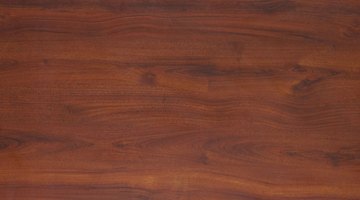How to Make Particle Board Furniture Look Like Wood
Painting particle board furniture with a faux wood finish is significantly cheaper than purchasing new wood furniture and creates an authentic-looking wood finish. This is a time-consuming process because the many layers of glaze each require significant drying time.

Painting particle board furniture with a faux wood finish is significantly cheaper than purchasing new wood furniture and creates an authentic-looking wood finish. This is a time-consuming process because the many layers of glaze each require significant drying time. Since the technique does take a little practice, experiment on a piece of scrap particle board before you begin on the furniture.
Things You Will Need
- Dust sheets/newspaper
- Standard paint brushes
- Primer
- Brown-tinted glaze
- Two-inch paintbrush
- Lint-free cloth
- Clear glaze
- Artist's paintbrush
- Varnish
-
Stand your sanded particle board furniture on a dust sheet or lots of newspaper in a well ventilated area.
-
Paint a coat of primer onto the furniture, allow it to dry, and apply a second coat. Allow to dry thoroughly as per the manufacturer's instructions before proceeding to the next step.
-
Take a clean paintbrush, dip it in the brown glaze,s and apply to the furniture using random strokes. Don't cover the entire piece, as you will need to work with the glaze before it dries. Work on one surface at a time.
-
Take a two-inch paintbrush and drag the brush in long, vertical strokes through the glaze. Overlap each stroke to ensure there are no gaps. After each vertical stroke, use a lint-free cloth to wipe excess glaze off the bristles. This prevents the brush from becoming overloaded, which will cause the glaze to clump up and ruin the effect.
-
Lightly tap the tips of the paintbrush bristles over the glaze to create further texture. Don't press too hard or you will ruin the long, vertical strokes you just created. In the same way as when you created the vertical strokes, remove excess glaze from the brush with a lint-free rag every few taps. Allow the surface to dry for 24 hours.
-
Apply as thin coat of clear glaze and wait approximately 15 minutes for it to become tacky, but not dry.
-
Dip an artist's paintbrush into brown-tinted glaze and paint a wood grain pattern onto the tacky glaze. Refer to pictures or a real piece of wood to give you an idea of how the grain pattern should look.
-
Using the same tinted glaze, lightly flick the bristles over the surface as you did in step 5. Again, do not press to hard or drag the bristles across the surface, as this will run the grain paint effect. Allow the glaze to dry for 24 hours.
-
Apply a coat of matte or stain varnish, depending on whether you prefer a natural or polished-wood finish. Let the coat dry completely before using the piece.
The Drip Cap
- Painting particle board furniture with a faux wood finish is significantly cheaper than purchasing new wood furniture and creates an authentic-looking wood finish.
- Take a two-inch paintbrush and drag the brush in long, vertical strokes through the glaze.
- Overlap each stroke to ensure there are no gaps.
- Allow the surface to dry for 24 hours.
- Using the same tinted glaze, lightly flick the bristles over the surface as you did in step 5.
- Again, do not press to hard or drag the bristles across the surface, as this will run the grain paint effect.
Writer Bio
Based in England, Tami Mason writes for Local.com and various other websites. Mason has worked as a proofreader and copy editor since 2007 and is a trained interior designer who also specializes in art history, art and crafts.
Photo Credits
- Brand X Pictures/Brand X Pictures/Getty Images
- Brand X Pictures/Brand X Pictures/Getty Images
More Articles



